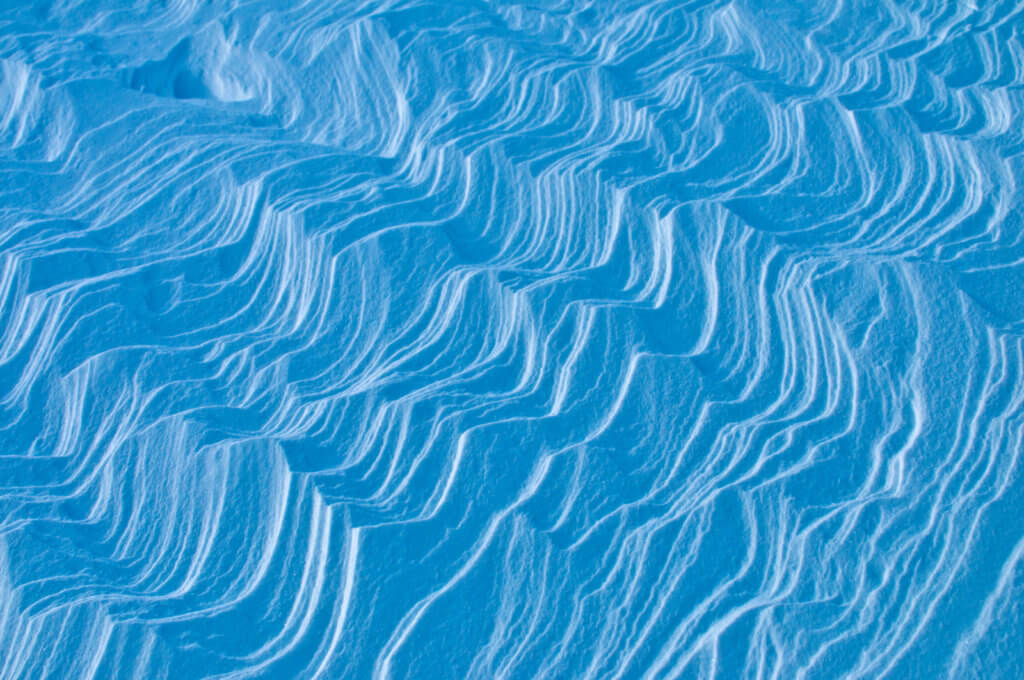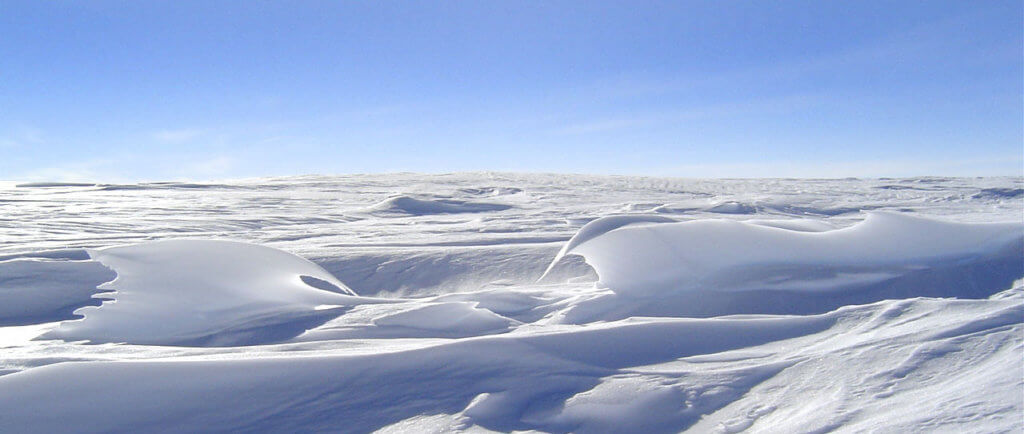by Hilary Wood

Wind-sculpted dunes on the eastern side of Glacier National Park. Photo by Steven Gnam.
I had been hiking all day, making good time despite the soft snow and constant wind. It was well below zero and twilight grey by the time I started across the frozen surface of the lake toward the dim outline of my car and its high-powered heater. Thoughts of warmth and a candy bar made me want to quicken my steps, which were slowed to a frustrating crawl by the unpredictable footing. The wind had sculpted the deep snow on the lake into delicate-looking ridges, their sides brittle and fluted as carved ivory. Even my steel-clawed snowshoes were not helpful as these mini-dunes caused me to pitch and fall beneath the weight of my backpack. They stretched out before me in waves, stiff and peaked as meringue.
What was it that stood between me and my Snickers bar? Sastrugi. Although the word sounds like a type of Italian pastry or noodle dish, it’s actually a Russian word used to define sharp ridges of snow sculpted by wind. They appear everywhere, from backyards to Siberia, creating intricate patterns and impeding foot travel. Under some conditions, they are called dunes, shaped by the same force as the vast sand deserts of the Sahara and Gobi.
Sastrugi are formed in open areas where the wind’s velocity is unimpeded by vegetation. As the wind-blown snow moves across a field or lake surface, it is thrown off course a bit by surface irregularities like hills or small depressions. These irregularities get filled in by blowing snow and molded into crescent-shaped sastrugi. Similar to desert dunes, the steep side of sastrugi always forms away from the wind, to the lee side. How far the crests extend depends on the velocity of the wind and the amount and quality of the snow. If it’s really cold, sastrugi may be composed of rime ice, which causes their edges to be sharp and brittle.
Although they make walking difficult, sastrugi can be helpful. Accounts from Captain Robert Scott’s expedition to the Antarctic in 1910 mention that sastrugi were used to indicate direction. By knowing the direction of the wind, the explorers could set a course by walking at a steady angle to the sastrugi. In white-out conditions, the blinded team resorted to feeling the sastrugi with their feet in order to maintain their direction across the otherwise featureless ice sheet.

Antarctic sastrugi. Photo NSIDC courtesy Ted Scambos and Rob Bauer.
Unlike Scott, I could see my destination. But it took time to cross that ocean of sastrugi, enough for me to wish that I had chosen that path around the lake rather than this presumed short cut. The sun had just set by the time I reached my car, giving the sky and snow a dull pearlish luster. The sastrugi swept out behind me like a vast mountain range in miniature, finally beautiful after so much work. A candy bar never tasted better….
This essay first aired as a Field Note on Montana Public Radio in February 1999. Hilary Wood’s company, Small Dog Solutions, specializes in customized website design and development.
This article was originally published in the Winter 2011-2012 issue of Montana Naturalist magazine, and may not be reproduced in part or in whole without the written consent of the Montana Natural History Center. ©2011 The Montana Natural History Center.
Click here to read more articles from Montana Naturalist magazine.
Want to learn more about our programs? Sign up for our e-newsletter! You can also become a member and get discounts on our programs as well as free reciprocal admission to 300+ science centers in North America!












